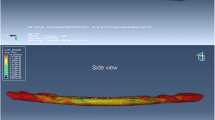Abstract
The most common injury in dogs, especially medium and large breeds, is a cranial cruciate ligament (CCL) rupture at the knee joint. It is possible to reconstruct an injury using innovative implants made with 3D printing technologies from biodegradable material. The selected material must be biocompatible and have an appropriate degradation rate to reduce the risk of reoperation, and the treated bone could regenerate and heal. The properties of the implant are also influenced by the design and printing parameters. Therefore, this article aimed to assess 3D printing parameters on the properties of novelty implant construction. Used implants were made of polylactide (PLA) designed by Cabiomede. The geometry of the implants was adapted to medium-breed dogs. Five types of implants, differing only in printing parameters, were printed using the FDM method. To reflect the real conditions, the implants were divided into sterilization and 8, and 12 weeks soaked in Ringer's solution. As part of the research, microscopic observations, surface wettability, roughness, Shore hardness, and static compression were carried out. Polymer equivalents of traditional metal implants can be successfully used in surgical procedures and they comply with the requirements of physicochemical and mechanical properties.
Access this chapter
Tax calculation will be finalised at checkout
Purchases are for personal use only
Similar content being viewed by others
References
Kowaleski, M.P., Boudreau, R.J., Pozzi, A.: Stifle Joint” Veterian Key, Fastest Veterinary Medicine Insight Engine, Chapter 62
Sellon, D.C., Marcellin-Little, D.J.: Risk factors for cranial cruciate ligament rupture in dogs participating in canine agility. BMC Vet. Res. 18, 39 (2022)
Torres de la Riva, G., Hart, B.L., Farver, T.B., Oberbauer, A.M., Messam, L.L.M., Willits, N., et al.: Neutering Dogs: Effects on Joint Disorders and Cancers in Golden Retrievers. PLoS ONE 8(2), e55937 (2013)
ISO 25178: Geometrical Product Specifications (GPS) – Surface texture: areal
ISO 868:2003: Plastics and ebonite — Determination of indentation hardness by means of a durometer (Shore hardness)
PN-EN ISO 604:2006: Plastics – Determination of compressive properties
Nowak Bożena, Pająk Jolanta: Biodegradacja polilaktydu (PLA). Archiwum Gospodarki Odpadami i Ochrony Środowiska, 2, 1–10 (2010)
Hanon, M.M., Zsidai, L.: Comprehending the role of process parameters and filament color on the structure and tribological performance of 3D printed PLA. J. Mater. Res. Technol. 15, 647–660 (2021)
Pérez-Davila, S.: 3D-printed PLA medical devices: physicochemical changes and biological response after sterilisation treatments. Polymers 14(19), 4117 (2022). https://doi.org/10.3390/polym14194117
Maszybrocka, J., Dworak, M., Nowakowska, G., Osak, P., Łosiewicz, B.: The influence of the gradient infill of PLA samples produced with the FDM technique on their mechanical properties. Materials 4(15), 1304 (2022)
Author information
Authors and Affiliations
Corresponding author
Editor information
Editors and Affiliations
Rights and permissions
Copyright information
© 2024 The Author(s), under exclusive license to Springer Nature Switzerland AG
About this chapter
Cite this chapter
Cholewa, K., Brzóska, M., Krutyło, K., Gawron, A., Pawlik, M., Antonowicz, M. (2024). Influence of 3D Printing Parameters on the Mechanical Properties of Veterinary Implants Used for the Treatment of CCL Rupture. In: Gzik, M., Paszenda, Z., Piętka, E., Tkacz, E., Milewski, K., Jurkojć, J. (eds) Innovations in Biomedical Engineering 2023. Lecture Notes in Networks and Systems, vol 875. Springer, Cham. https://doi.org/10.1007/978-3-031-52382-3_11
Download citation
DOI: https://doi.org/10.1007/978-3-031-52382-3_11
Published:
Publisher Name: Springer, Cham
Print ISBN: 978-3-031-52381-6
Online ISBN: 978-3-031-52382-3
eBook Packages: Intelligent Technologies and RoboticsIntelligent Technologies and Robotics (R0)




